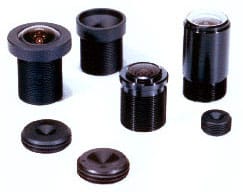High resolution lenses for machine vision — standard and custom lens design
Advantages Of CCD Cameras
High Resolution Lenses for machine vision, instrumentation, inspection and vibration-sensitive applications. Standard and custom hi-res lens assemblies.

CCD Cameras
A CCD (charge-coupled device) camera was first used in the late 1960s; it captures and stores images in digital memory. The CCD cameras are utilized in both scientific and technology fields. CCDs are found in photocopiers, security surveillance cameras, fax machines and are used in mammography, dentistry X-rays and camcorders as well as handheld cameras. Digital cameras used today contain a CCD image sensor that captures and stores the digital prints. CCD cameras are used in astronomical research fields.
Bell Labs invented the charge couple device in 1969 and it was originally thought to be a new type of computer memory circuit. The CCD is charged by light and has a silicon finish; these devices are extremely sensitive to light. The inventors of the technology, George E. Smith and Willard Boyle determined that because of the CCD’s light sensitivity that it would help cameras to capture more clear images because the more light that is collected, the more precise and clear the image will be. Digital cameras were the ideal outlet for CCD image sensors.
Rather than using film, as the original cameras did, a digital camera houses a CCD image sensor to collect the light. The light inside the camera is captured and “placed” onto the silicon finish on the sensor. The image sensor converts the light into electrons which then convert the light into digital images.
The beauty of CCD cameras is that it provides a low-noise, high quality image at a highly pixilated resolution. Digital cameras capture and measure light in the hues of blue, green and red; the quality of the image depends on the quality of the camera purchased. Digital cameras are equipped with from one to three CCD arrays which decipher the hues. You will typically find a camera with one CCD array being deployed for security surveillance and in other uses when precision color images aren’t necessary.
High-tech CCD cameras are utilized in astrophotography and life sciences and this technology is also used on the Hubble Telescope because CCD cameras allow for long exposure times. When a CCD camera is used in a telescope, the eyepiece is removed and the camera is attached in its place. A CCD camera is capable of capturing up to 70 percent of the available light, as compared to the two percent of available light captured with lower quality cameras.
CCD cameras are designed for specific use, and knowing what you’ll be asking of it will help you make your purchasing decision. CCD cameras are manufactured with c-mount or t-mounts and are also equipped with an adaptor to connect to a computer for ease in displaying the images.